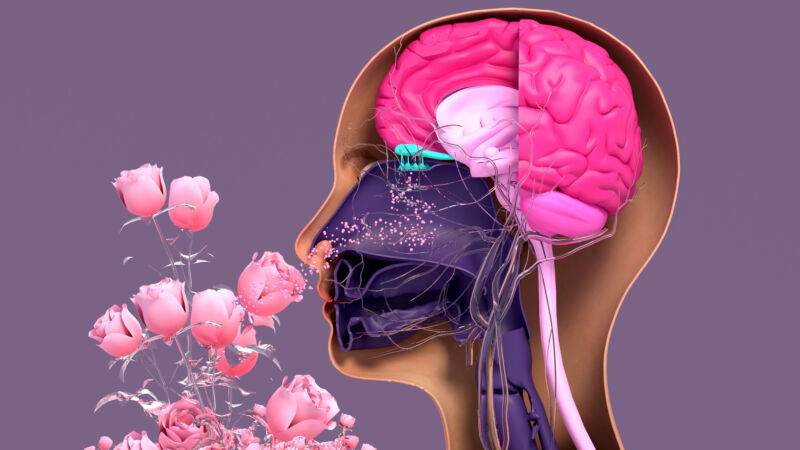 reader comments 16
reader comments 16 When we catch a whiff of perfume or indulge in a scented candle, we are smelling much more than Floral Fantasy or Lavender Vanilla. We are actually detecting odor molecules that enter our nose and interact with cells that send signals to be processed by our brain. While certain smells feel like they’re unchanging, the complexity of this system means that large odorant molecules are perceived as the sum of their parts—and we are capable of perceiving the exact same molecule as a different smell.
Smell is more complex than we might think. It doesn’t consist of simply detecting specific molecules. Researcher Wen Zhou and his team from the Institute of Psychology of the Chinese Academy of Sciences have now found that parts of our brains analyze smaller parts of the odor molecules that make things smell.
Smells like…
So how do we smell? Odor molecules that enter our noses stimulate olfactory sensory neurons. They do this by binding to odorant receptors on these neurons (each of which makes only one of approximately 500 different odor receptors). Smelling something activates different neurons depending on what the molecules in that smell are and which receptors they interact with. The sensory neurons in the piriform cortex of the brain then use the information from the sensory neurons and interpret it as a message that makes us smell vanilla. Or a bouquet of flowers. Or whatever else.
Odor molecules were previously thought to be coded only as whole molecules, but Zhou and his colleagues wanted to see whether the brain’s analysis of odor molecules could perceive something less than a complete molecule. They reasoned that, if only whole molecules work, then after being exposed to a part of an odorant molecule, the test subjects would smell the original molecule exactly the same way. If, by contrast, the brain was able to pick up on the smell of a molecule’s substructures, neurons would adapt to the substructure. When re-exposed to the original molecule, subjects would not sense it nearly as strongly.
Advertisement“If [sub-molecular factors are part of our perception of an odor]—the percept[ion] and its neural representation would be shifted towards those of the unadapted part of that compound,” the researchers said in a study recently published in Nature Human Behavior.
Doesn’t smell like…
To see whether their hypothesis held up, Zhou’s team presented test subjects with a compound abbreviated CP, its separate components C and P, and an unrelated component, U. P and U were supposed to have equal aromatic intensity despite being different scents.
In one session, subjects smelled CP and then sniffed P until they had adapted to it. When they smelled CP again, they reported it smelling more like C than P. Despite being exposed to the entire molecule, they were mostly smelling C, which was unadapted. In another session, subjects adapted to U, after which there was no change in how they perceived CP. So, the effect is specific to smelling a portion of the odorant molecule.
In yet another experiment, subjects were told to first smell CP and then adapt to the smell of P with just one nostril while they kept the other nostril closed. Once adapted, CP and C smelled similar, but only when snorted through the nostril that had been open. The two smelled much more different through the nostril that had been closed.
Previous research has shown that adaptation to odors takes place in the piriform cortex. Substructure adaptation causes this part of the brain to respond differently to the portions of a chemical that the nose has recently been exposed to.
This olfactory experiment showed that our brains perceive smells by doing more than just recognizing the presence of a whole odor molecule. Some molecules can be perceived as a collection of submolecular units that are perceived separately.
“The smells we perceived are the products of continuous analysis and synthesis in the olfactory system,” the team said in the same study, “breath by breath, of the structural features and relationships of volatile compounds in our ever-changing chemical environment.”
Nature Human Behaviour, 2024. DOI: 10.1038/s41562-024-01849-0



















